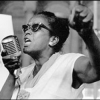Ella Baker

Ella Baker
Ella Josephine Bakerwas an African-American civil rights and human rights activist. She was a largely behind-the-scenes organizer whose career spanned over five decades. She worked alongside some of the most famous civil rights leaders of the 20th century, including W. E. B. Du Bois, Thurgood Marshall, A. Philip Randolph, and Martin Luther King, Jr. She also mentored many emerging activists such as Diane Nash, Stokely Carmichael, Rosa Parks, and Bob Moses. She was a critic of professionalized, charismatic leadership and...
NationalityAmerican
ProfessionCivil Rights Leader
Date of Birth13 December 1903
CityNorfolk, VA
CountryUnited States of America
In '32 we organized the Young Negroes' Cooperative League and had some degree of success in terms of establishing stores and certainly buying clubs in various sections of the country. I was designated as - I don't know what exactly - I believe it was director. I'm not sure what it was, but it had to do with getting out the necessary mail and all of that - organization.
I suppose that the first organized effort that might be considered something of civil rights was the Young Negroes' Cooperative League. Now, this offers certain contradictions at this point, perhaps, because it was stimulated by the writings of George Schayler who, at this point, is considered an arch-conservative, I understand.
I think the reasons for not selecting persons like the Reverend Borders and John Wesley Dobbs were, in my book rather obvious reasons: because they were people who were basically oriented in the direction of the established method of not confronting the power structure, but trying to elicit concessions by various and sundry means of, well, let's call it accommodating leadership.
[Walter White] had keep [people] waiting while you got the impression that he was terribly busy with calls to Washington. I've seen such exhibitions in that direction as having someone come out of his office to the switchboard operator - which at that time was sort of located in the center of wherever people were waiting - and ask to call such-and-such a place, or a call through to Mr. So-and-so, or somebody like this, you see.
One of the particular things that impressed me was one visitor [of NAACP] - I think it was - it wasn't the Prime Minister of England. We were located then on 14th Street and Fifth Avenue, up several flights of rickety stairs, and he came all the way up those stairs to see Walter [White], largely because of certain kinds of impact, I think, that the Association seemingly was having.
I think you can find some rationales for that if we look at the background out of which he came. Martin [Luther King] had come out of a highly competitive, black, middle-class background.
I guess the best way to describe that would be to connect with the fact that I came out of college just before the big Depression, and I came to New York.
Student Nonviolent Coordinating Committee was more politically oriented. Part and parcel of the initial SNCC efforts was to not only go in for voter registration, but for political participation.
After the '57 initial meeting - I was up this way working, not as a staff person - there became the need for a much more definite organized office. What you'd had prior to that time were these big meetings in different places, and there was nobody to pull anything together. Everything was left to [Martin Luther] King and the group that was around him.
I'm sure, out of the context here of Stanley Levison's relationship with the Jewish liberal forces, that had made contributions. I remember one such contribution before they moved from Montgomery. An associate in the real estate business with Stanley had lost a son in the war, and she wanted to do something in memory of him. So, she made available certain monies to be used by the emerging leadership there in Montgomery. I'm sure other individuals did.
Nixon was the one force in Montgomery for a number of years that made any effort in the direction of challenging the power structure. Ed Nixon's source of direction for that comes out of his relationship with the Brotherhood of Sleeping Care Porters and the Randolph philosophy of mass action. So, Ed Nixon really was the force that conceived of the boycott and drew up the original papers for the boycott.
I didn't have any close relationship with him because, although [William Edward Burghardt] DuBois may not have been as egocentric - I don't know - he certainly was not the easiest person to approach. I think, certainly, those of us who were younger sort of respected that in terms of his preoccupation with deep thoughts. So, I made no effort to establish any relationship with him. However, he was in and out then.
This In Friendship - out of it came certain connections with the liberal labor establishment. Among the personalities that were involved were Bayard Rustin and a person from the American Jewish Congress, Stanley Levinson.
I don't think that the leadership of Montgomery was prepared to capitalize, let's put it, on the projection that had come out of the Montgomery situation. Certainly, they had not reached the point of developing an organizational format for the expansion of it. So discussions emanated, to a large extent, from up this way.